William Rivers Pitt: Nuremberg Revised
Nuremberg Revised
By William Rivers Pitt
From: http://www.truthout.org/docs_04/061504A.shtml
t r u t h o u t | Perspective
Tuesday 15 June 2004
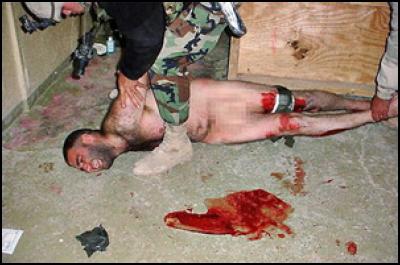
The document is titled 'Standards of Conduct for Interrogation under U.S.C. 2340-2340A.' It is a memo dated August 1, 2002, and was written at the specific request of Alberto R. Gonzales, Counsel to the President of the United States of America.
U.S.C. 2340, one of two sections of the U.S. Code referred to in the August 1 memo, reads as follows:
(1) "torture" means an act committed by a person acting under the color of law specifically intended to inflict severe physical or mental pain or suffering (other than pain or suffering incidental to lawful sanctions) upon another person within his custody or physical control;(2) "severe mental pain or suffering" means the prolonged mental harm caused by or resulting from -
(a) the intentional infliction or threatened infliction of severe physical pain or suffering;
(b) the administration or application, or threatened administration or application, of mind-altering substances or other procedures calculated to disrupt profoundly the senses or the personality;
(c) the threat of imminent death; or
(d) the threat that another person will imminently be subjected to death, severe physical pain or suffering, or the administration or application of mind-altering substances or other procedures calculated to disrupt profoundly the senses or personality.
U.S.C. 2340A reads as follows:
(a) Offense. - Whoever outside the United States commits or attempts to commit torture shall be fined under this title or imprisoned not more than 20 years, or both, and if death results to any person from conduct prohibited by this subsection, shall be punished by death or imprisoned for any term of years or for life.
(b) Jurisdiction. - There is jurisdiction over the activity prohibited in subsection A if -
(1) the alleged offender is a national of the United States; or
(2) the alleged offender is present in the United States, irrespective of the nationality of the victim or alleged offender.
The first paragraph of the August 1 memo to Gonzales reads as follows:
We conclude below that Section 2340A proscribes acts inflicting, and that are specifically intended to inflict, severe pain or suffering, whether mental or physical. Those acts must be of an extreme nature to rise to the level of torture within the meaning of Section 2340A and the Convention. We further conclude that certain acts may be cruel, inhuman or degrading but still not produce pain and suffering of the requisite intensity to fall within 2340A's proscription against torture.
The Convention' referred to in that paragraph is the Convention against Torture and Other Cruel, Inhuman or Degrading Treatment or Punishment, which was ratified by the United States in 1994. As with any treaty ratified by the U.S., the Convention against Torture carries the full force of law.
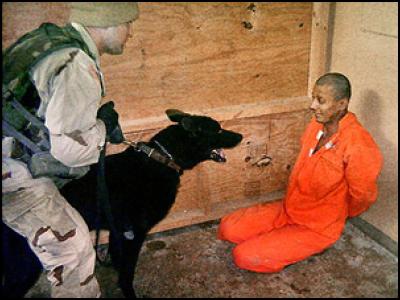
Note well the import of that first paragraph from the August 1 memo. The argument leaps blithely over the definitions of torture as described in U.S.C 2340, and proceeds directly to the import of 2340A, the section which demands a 20 year prison term for any American who tortures another human being. If the person being tortured should die, U.S.C. 2340A demands the death penalty for the American responsible.
The limited series of photographs which has been released from the Abu Ghraib prison in Iraq requires us, as American citizens, to consider carefully those definitions of torture in U.S.C. 2340. They are straightforward and unambiguous, as an American law should be.
A review of a segment of the photographs released from Abu Ghraib reveals:
- Men ordered to masturbate in front of each other and in front of female American soldiers, a humiliating experience which offends their religion (see: "The application of procedures calculated to disrupt profoundly the senses or personality");
- Men ordered to simulate homosexual sex with one another, a humiliating experience condemned by their religion (see: "The application of procedures calculated to disrupt profoundly the senses or personality");
- A man, hooded, standing on a box with electrodes attached to his fingers and penis, who was told that if he stepped off the box, he would be electrocuted to death (see: "Prolonged mental harm caused by or resulting from the intentional infliction or threatened infliction of severe physical pain or suffering, the threat of imminent death");
- A naked man menaced by, and then attacked by, a vicious dog (see: "Prolonged mental harm caused by or resulting from the intentional infliction or threatened infliction of severe physical pain or suffering, the threat of imminent death");
- A man lying dead swathed in a plastic bag with two U.S. soldiers grinning up at the camera and flashing a thumbs-up sign (see: "Whoever outside the United States commits or attempts to commit torture shall be fined under this title or imprisoned not more than 20 years, or both, and if death results to any person from conduct prohibited by this subsection, shall be punished by death or imprisoned for any term of years or for life").
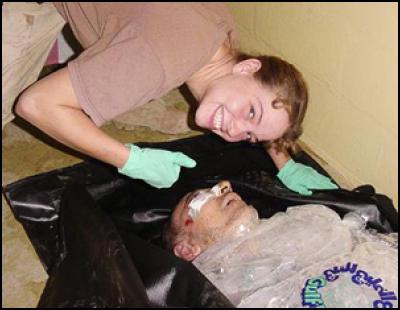
This is what we have been allowed to see, but there is more. Seymour Hersh, the reporter who first broke the Abu Ghraib story, spoke recently at the University of Chicago. Hersh is one of the few people alive today who has seen all of the photographic evidence of the torture which took place in that prison. "You haven't begun to see evil," he said, "horrible things done to the children of women prisoners, as the cameras run." Words like "Rape" and "Murder" have been used to describe the evidence which remains as yet unreleased.
The Bush administration is scrambling to defend itself against accusations that section 2340 has been grossly violated with intent, which means a number of American officials stand in peril of punishment as demanded by section 2340A. Not long ago, administration officials described the barbarism at Abu Ghraib as the rogue behavior of a few wretches, and not a policy deliberately formulated and put into effect. The leaking of memos like that from August 1st, several of which have since been deemed 'Classified' and which Attorney General Ashcroft is refusing to release, prove this defense to be a bald-faced lie.
The truth is that, beginning as early as 2002, the Bush administration worked long and hard to come up with as many justifications as possible for the horrors we have seen from Abu Ghraib, the purpose of said justifications being to defend Administration officials from the punishments required by law for those who engage in the torture of their fellow human beings. The sum and substance of these defenses would hold that what happened at Abu Ghraib was not torture, and even if it was, the President of the United States can do whatever he wants.
This broad exculpation of George W. Bush was delineated in another memo, dated March 2003, and titled 'Working Group Report on Detainee Interrogations in the Global War on Terrorism.' In this report, now classified, torture is justified because, "The president's inherent constitutional authority to manage a military campaign" frees him to behave however he wishes. By this rationale, legal prohibitions like those found in U.S.C. 2340 and the Convention against Torture, "must be construed as inapplicable to interrogations undertaken pursuant to his commander in chief authority."
The March 2003 report goes on to say that torture can be justified by necessity. This 'Doctrine of Necessity' would have us believe that any horror performed against another human being is justified because it supposedly ensures that no more terror attacks will happen. The rationale reaches back to the disgraced and discredited Nuremberg Defense, once put forth by the Nazis, which would pardon dealers of death and agony because they were just following orders. In this case, according to these Bush administration memos, those orders came from a President not bound by law because of the aforementioned Necessity Doctrine.
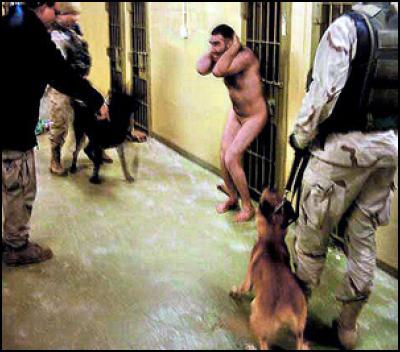
There are two clear holes in this disturbing rationale:
1. The Convention against Torture, given the force of American law in 1996, states: "No exceptional circumstances whatsoever, whether a state of war or a threat of war, internal political instability or any other public emergency, may be invoked as a justification of torture." Simply put, there is no rationale available to George W. Bush or any of his people that removes them from the need to obey the law.
2. The original reason for the development of these legal excuses for torture came about because American military and intelligence officials felt they were not getting enough information from Taliban and al Qaeda detainees using 'conventional' interrogation techniques. The people tortured in Abu Ghraib, however, were not Taliban, were not al Qaeda, were not capable of perpetrating the kind of terrorist attacks against the United States which created the rationale for this 'Necessity Doctrine' in the first place. Those tortured and killed were not terrorists, but were Iraqi civilians unjustly swept up by American forces. There is no aspect of the 'Doctrine of Necessity' which can justify the torture and murder of innocent people.
According to the UK Telegraph, the Nuremberg Defense is about to be tested again, but this time it will be the American government under the hammer. A report from the Telegraph dated June 13th states, "New evidence that the physical abuse of detainees in Iraq and at Guantanamo Bay was authorized at the top of the Bush administration will emerge in Washington this week, adding further to pressure on the White House. The Telegraph understands that four confidential Red Cross documents implicating senior Pentagon civilians in the Abu Ghraib scandal have been passed to an American television network, which is preparing to make them public shortly."
According to lawyers familiar with the Red Cross reports," continues the Telegraph, "they will contradict previous testimony by senior Pentagon officials who have claimed that the abuse in the Abu Ghraib prison was an isolated incident. 'There are some extremely damaging documents around, which link senior figures to the abuses,' said Scott Horton, the former chairman of the New York Bar Association, who has been advising Pentagon lawyers unhappy at the administration's approach. 'The biggest bombs in this case have yet to be dropped.'"
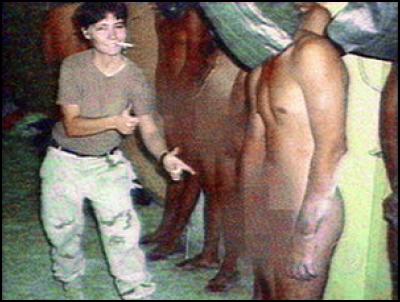
These four Red Cross documents will likely become part of the defense being mounted by attorneys representing Lynndie England, the woman featured in several Abu Ghraib photographs. England has been portrayed as some sort of Dragon Lady, one of the wretches who tortured Iraqi civilians all on their own. England's attorneys have put forth a list of 100 witnesses they intend to put on the stand to prove that she was acting under orders, and not on her own. The excuses prepared for George W. Bush and his people, like the August 1 memo and the March 2003 report, support her claim that she was just following orders.
Some of those witnesses include Vice President Dick Cheney, Defense Secretary Donald Rumsfeld, Deputy Defense Secretary Paul Wolfowitz, Defense Undersecretary for Intelligence Stephen Cambone, Lt. Gen. Ricardo Sanchez, commander of U.S. forces in Iraq, and White House General Counsel Alberto Gonzales.
It would be the final irony of this matter to have a person like Lynndie England be central to the process of bringing the true barbarians in this horror show to justice. It would be the final irony of this matter to have this woman, who tortured her fellow human beings with a smile on her face, be instrumental in bringing about the final and long-overdue death of the Nuremberg Defense.
William Rivers Pitt is the senior editor and lead writer for truthout. He is a New York Times and international bestselling author of two books - 'War on Iraq: What Team Bush Doesn't Want You to Know' and 'The Greatest Sedition is Silence.'


 Martin LeFevre - Meditations: Animal Encounters During Meditative States
Martin LeFevre - Meditations: Animal Encounters During Meditative States Ian Powell: Gisborne Hospital Senior Doctors Strike Highlights Important Health System Issues
Ian Powell: Gisborne Hospital Senior Doctors Strike Highlights Important Health System Issues Keith Rankin: Who, Neither Politician Nor Monarch, Executed 100,000 Civilians In A Single Night?
Keith Rankin: Who, Neither Politician Nor Monarch, Executed 100,000 Civilians In A Single Night? Eugene Doyle: Writing In The Time Of Genocide
Eugene Doyle: Writing In The Time Of Genocide Gordon Campbell: On Wealth Taxes And Capital Flight
Gordon Campbell: On Wealth Taxes And Capital Flight Ian Powell: Why New Zealand Should Recognise Palestine
Ian Powell: Why New Zealand Should Recognise Palestine